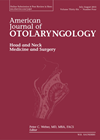
Journal Reviews
Evolution of salivary gland pathology classifications
Targeted therapies for malignant salivary gland tumours have changed the treatment paradigm and therapy approaches. Better outcomes are now feasible. Choosing the treatment method requires a clear classification of the lesions. The authors of this paper reviewed the World Health...
Parapharyngeal space tumours – is the transoral approach effective?
Several approaches are described to the parapharyngeal space to permit resection of tumours in this region, with the most commonly employed approach being the transcervical route. The transoral approach remains somewhat controversial as it is felt that this approach can...
Sublingual gland tumour resection
This paper from South Korea analyses the pathology arising from 20 malignant sublingual gland tumours. Adenoid cystic carcinoma followed by mucoepidermoid carcinomas were the most common. Tumour invasion into the lingual nerve was detected in 40% of cases, and into...
Is there a limitation for excising parapharyngeal tumours transorally?
The parapharyngeal space is a complex anatomical space bounded medially by the oropharynx and laterally by the mandible. It is conceptualised as an inverted pyramid extending from base of skull above to the hyoid bone below. The space is divided...
Salivary pepsin – a simple test for LPR?
A diagnosis of laryngopharyngeal reflux (LPR) can be made on the basis of characteristic symptoms and nasendoscopy findings. Objective tests exist for this condition; for example, 24-hour dual-channel pH-metry which is considered to be the gold standard. Such tests are,...
Identifying clinically useful salivary substitutes
This in vitro study analysed the efficacy of salivary substitutes used in the treatment of xerostomia following head neck irradiation. The researchers applied the products under evaluation onto a synthetic surface and onto cellular gingival models. The products were then...
Plunging new depths for the treatment of ranulas
Within our scope of practice, we encounter a number of salivary gland pathologies, including the sublingual gland. Clinical signs are often subtle, and even with meticulous surgical management, morbidity can easily occur. Textbooks advocate excision of the gland as the...












